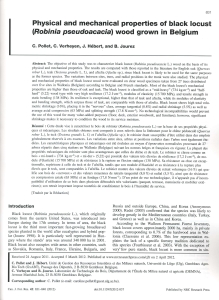Pollet C., Verheyen C., Hébert J. , Jourez B.
Cette étude vise à caractériser le bois de robinier (Robinia pseudoacacia L.) sur la base de ses propriétés physiques et mécaniques. Les résultats obtenus sont comparés à ceux relevés dans la littérature pour le chêne pédonculé (Quercus robur L.), le teck (Tectona grandis L. f.) et l’afzélia (Afzelia sp.)
Résumé EN. The objective of this study was to characterize black locust (Robinia pseudoacacia L.) wood on the basis of its physical and mechanical properties. The results are compared with those reported in the literature for English oak (Quercus robur L.), teak (Tectona grandis L. f.), and afzelia (Afzelia sp.), since black locust is likely to be used for the same purposes as the former species. The variations between sites, trees, and radial positions in the trunk were also studied. The physical and mechanical properties of black locust wood were evaluated on clear wood specimens taken from 27 trees distributed over five sites in Wallonia (Belgium) according to Belgian and French standards. Most of the black locust’s mechanical properties are higher than those of oak and teak. The black locust is classified as a “mid-heavy” (734 kg·m–3) and “half-hard” (5.22) wood type with very high resilience (17.2 J·cm–2), modulus of elasticity (15 700 MPa), and tensile strength in static bending (138 MPa). Its resilience is exceptional, higher than that of teak and afzelia, while its modulus of elasticity and bending strength, which surpass those of teak, are comparable with those of afzelia. Black locust shows high total volumetric shrinkage (16%), placing it in the “nervous” class, average tangential (8.8%) and radial shrinkage (5.5%) as well as average axial compressive (63 MPa) and splitting strength (17.8 N·mm–1). No technological incompatibilities would prevent the use of this wood for many value-added purposes (floor, deck, exterior woodwork, and furniture); however, significant shrinkage makes it necessary to condition the wood to its service moisture.
Consultez la notice complète de l’article sur ORBi

